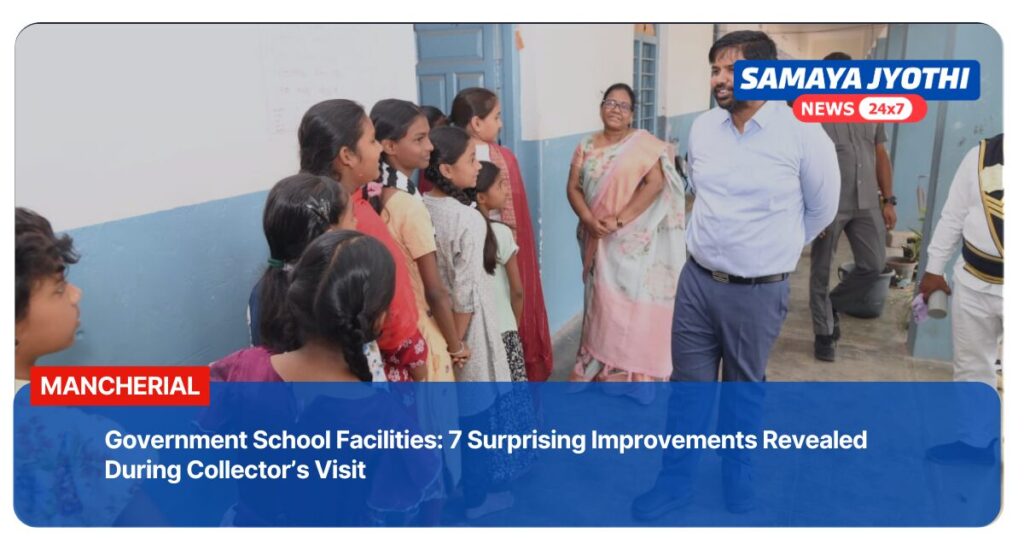- Home
- India, Latest News
- Government School Facilities: 7 Ultimate Positive Insights You Need Now
Government School Facilities: 7 Surprising Improvements Revealed During Collector’s Visit
Government School Facilities were put under the spotlight when District Collector Kumar Deepak visited Zilla Parishad Boys’ High School and Zilla Parishad Girls’ High School. In an in‑depth inspection, he reviewed classrooms, kitchen, RO plant, attendance tables, registers, and overall surroundings. This article explores the array of facilities provided to students in these government schools, highlighting strengths, challenges, and recommendations.
Government School Facilities: Classrooms and Learning Environment
Government School Facilities include properly structured classrooms with adequate furniture—benches, desks, blackboards, and teaching aids. During the inspection, Mr. Kumar Deepak noted that classrooms were well‑ventilated and lit, arranged to create a conducive learning environment. Safe electrical fixtures, fans, and notice boards were present as well.
A supportive ambiance with clean walls and educational displays engages students, promoting better learning outcomes. District administration ensures periodic maintenance, whitewashing, and seating repairs. This reflects commitment to improving the educational atmosphere in government schools.
Government School Facilities: Clean Drinking Water (RO Plant)
One of the critical Government School Facilities is access to safe drinking water through RO plants. At both schools, RO plants were functional, with regular checks for filter replacement and sanitization. These improvements ensure students drink clean water, reducing health risks like waterborne diseases.
Proper infrastructure around the RO area, including drainage and space for vessels, reflects planning. Daily logs of water testing foster accountability from school management, maintaining high standards.
Government School Facilities: Kitchen and Mid‑Day Meal Infrastructure
Government School Facilities extend to mid‑day meal infrastructure. The kitchens in both schools are clean, well‑ventilated, and accommodated modern utensils. Food preparation areas are separate from storage areas, aligned with hygiene standards.
Hygienic practices like hand‑washing, clean aprons, and head caps were observed. Records of daily menus and attendance confirm effective mid‑day meal implementation. Potential nutritional enhancements—more protein and micronutrients—are being discussed to improve quality.
Government School Facilities: Kitchen and Mid‑Day Meal Infrastructure
Government School Facilities extend to mid‑day meal infrastructure. The kitchens in both schools are clean, well‑ventilated, and accommodated modern utensils. Food preparation areas are separate from storage areas, aligned with hygiene standards.
Hygienic practices like hand‑washing, clean aprons, and head caps were observed. Records of daily menus and attendance confirm effective mid‑day meal implementation. Potential nutritional enhancements—more protein and micronutrients—are being discussed to improve quality.
Government School Facilities: Attendance Tables and Registers
Accurate record‑keeping forms a key part of Government School Facilities. Attendance tables are maintained meticulously, and registers are up to date, documenting attendance, enrolment details, tranche of parents, and staff presence.
Such systematic maintenance helps in tracking dropout rates, absenteeism, and allows timely interventions. During the inspection, Mr. Deepak emphasized real-time digital attendance integration to reduce manual errors and improve transparency.
Government School Facilities: Cleanliness and Surroundings
School cleanliness is among the pivotal Government School Facilities. Classrooms, corridors, and verandahs were clean, free of waste. Garbage bins were placed, with segregation into wet and dry waste. The surroundings have been recently landscaped with trees, shrubs, and benches for breaks and outdoor learning.
To further enhance the environment, plans for flower beds, vegetable gardens, and eco‑friendly initiatives are underway. A clean setting uplifts morale and supports holistic development.
Government School Facilities: Additional Amenities
Beyond basics, the District Collector also inspected infrastructural and soft facilities:
Dedicated computer labs with functional desktops and internet access
Separate toilets for boys and girls with running water and soap
Safe boundary walls and security measures
Sports equipment for physical education
Electrical fittings and adequate lighting
These broadened Government School Facilities show a holistic commitment to education and student wellness.
Recommendations and Next Steps
Following the inspection, several action points were identified:
Expand Nutritional Value: Include protein‑rich foods, fortification to the mid‑day meals.
Digitize Attendance: Implement biometric or digital registers for accuracy.
Safety Audits: Upgrade electrical safety and emergency preparedness.
Eco‑Initiatives: Launch school gardens, rainwater harvesting.
Infrastructure Upgrades: Regular maintenance and smart classroom pilot programs.
Student Feedback Mechanism: Periodic surveys for students and teachers.
These recommendations aim to make Government School Facilities more child‑friendly, inclusive, and future‑ready. The District Collector’s inspection clearly reflects an active, positive governance drive toward upgrading rural education infrastructure.
Government School Facilities were comprehensively inspected by District Collector Kumar Deepak, emphasizing classrooms, RO plant, kitchens, attendance systems, and environment. While strong foundations are evident, focused enhancements can create a more enriching educational ecosystem. Continued monitoring and community participation remain key to sustainable progress.
Click for more latest news. Also get top headlines and latest news from India and around the world at samaya jyothi







